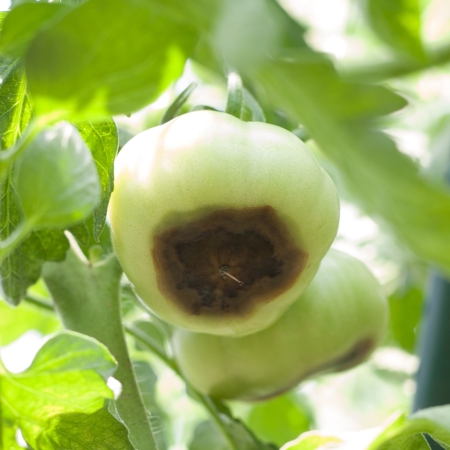Blossom End Rot (BER) is a common physiological disorder affecting crops like tomatoes and peppers. It typically manifests as dark, sunken lesions at the blossom end of the fruit, leading to significant quality deterioration and, in severe cases, complete loss of yield. Once the rot appears it can’t be reversed, so early prevention essential for safeguarding crop productivity.
Preventing BER requires a clear understanding of its causes and the underlying plant mechanisms involved.
 |  |
What Causes Blossom End Rot?
Blossom End Rot is primarily the result of calcium deficiency in the fruit tissues. Calcium is vital for building strong cell walls, and when it is lacking, plant cells become structurally weak. This structural collapse leads to tissue death and the visible symptoms of BER.
However, while the immediate cause is calcium deficiency in the fruit, multiple factors influence the plant’s ability to deliver enough calcium to developing fruits:
- Limited Calcium Availability: This can result from low calcium levels in the soil. More commonly — and harder to manage — low availability results from competition with other cations for root uptake. Magnesium, potassium, and ammonium-nitrogen are nutrients that may hinder calcium absorption. Sodium, which is harmful in other ways, also competes with calcium.
- Limited Calcium Mobility: Calcium is transported within the plant exclusively through the xylem – the water-conducting tissue. Therefore, calcium must travel from roots to shoots with the transpiration stream. Plant organs like stems and leaves, which experience intense water flow, typically receive sufficient calcium. Fruits, however, with much lower water movement, are particularly prone to calcium deficiency.
Water Flow Dynamics
During the day, transpiration creates a negative pressure that draws water – and calcium – upward, mostly toward the leaves. Only about 20% of the calcium reaches the fruits.
At night, when transpiration slows, water uptake continues via osmotic differences between the soil and the roots. This process builds positive root pressure, pushing water and calcium more uniformly throughout the plant – including the fruits.
Disruptions to this delicate water-calcium dynamic can increase the risk of BER.
Factors That Promote Blossom End Rot
Practically, several environmental and nutritional factors can hinder calcium uptake and transport to fruits, increasing the likelihood of BER:
Factors Related to Calcium Uptake
- Low Calcium Levels in Irrigation Water: Insufficient calcium in the water source limits plant availability.
- High Ammonium-to-Nitrate Ratio in Fertilization: Ammonium competes with calcium uptake, disrupting transport to fruits.
- Use of Urea-Based Fertilizers: Urea degrades into ammonium, intensifying competition with calcium.
- High Potassium and Magnesium Levels: Excessive K⁺ and Mg²⁺ can further compete with calcium uptake.
- Substrate Type: Nutrient balance issues are more pronounced in light soils and soilless media, while heavier soils provide some buffering.
Factors Related to Water Flow and Calcium Transport
- Low Nighttime Humidity: Especially during dry winds; BER is less severe in the cool, humid winter and the hot, humid summer.
- Irrigation Deficits: Under-irrigation increases soil salinity and makes water (and calcium) uptake more difficult.
- High Sodium Levels: Elevated sodium levels interfere with calcium uptake by both direct ion competition and by slowing the water flux through roots.
How to Prevent Blossom End Rot
Given the complexity of factors involved, a comprehensive management strategy is essential to prevent BER:
- Maintain Consistent Irrigation: Avoid fluctuations that disturb water flow to the fruits.
- Monitor and Manage Calcium Nutrition: Ensure an adequate calcium supply through Nutrigation™ (fertigation) solutions, and supplement with foliar feeding if necessary.
Discover Haifa’s calcium solutions:
|
- Use Balanced Fertilization: Choose fertilizers with a low ammonium content and appropriate nitrate levels. Minimize the use of urea, particularly during fruit development stages.
- Adjust Fertilizer Composition: Tailor fertilization programs based on soil type, crop stage, and environmental conditions to optimize calcium availability.
Use the NuriNet™ tool to generate an optimized Nutrigation™ (fertigation) program. - Control Salinity: Monitor water and soil salinity to prevent competitive ion interactions that limit calcium uptake.
Explore Haifa’s portfolio of chloride-free water-soluble fertilizers
While careful fertilization planning greatly reduces the risk of BER, it does not guarantee complete protection. Environmental factors can still occasionally disrupt calcium transport.
Thus, careful irrigation and nutrition management remain critical to preserving crop quality and achieving maximum yields.



